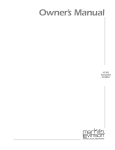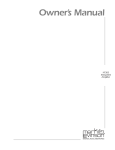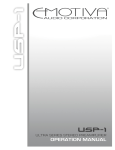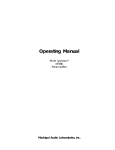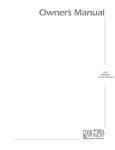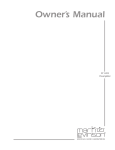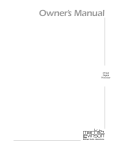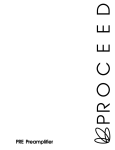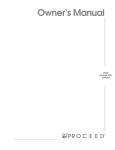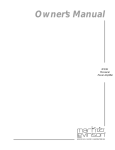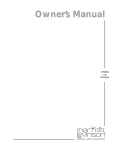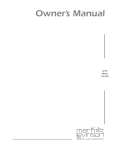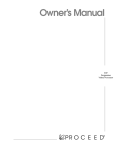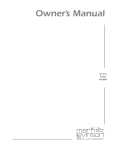Download Madrigal Audio Audio/Video Preamplifier Owner`s manual
Transcript
Owner’s Manual Nº32 Reference Preamplifier R Madrigal Audio Laboratories WARNING: TO REDUCE THE RISK OF FIRE OR ELECTRIC SHOCK, DO NOT EXPOSE THIS APPLIANCE TO RAIN OR MOISTURE. CAUTION RISK OF ELECTRIC SHOCK DO NOT OPEN CAUTION: TO REDUCE THE RISK OF ELECTRICAL SHOCK, DO NOT REMOVE COVER. NO USER-SERVICEABLE PARTS INSIDE. REFER SERVICING TO QUALIFIED PERSONNEL. The lightning flash with arrowhead symbol, within an equilateral triangle, is intended to alert the user to the presence of uninsulated “dangerous voltage” within the product’s enclosure that may be of sufficient magnitude to constitute a risk of electric shock to persons. The exclamation point within an equilateral triangle is intended to alert the user to the presence of important operating and maintenance (servicing) instructions in the literature accompanying the appliance. Marking by the “CE” symbol (shown left) indicates compliance of this device with the EMC (Electromagnetic Compatibility) and LVD (Low Voltage Directive) standards of the European Community. NOTICE This equipment has been tested and found to comply with the limits for a Class B digital device, pursuant to Part 15 of the FCC Rules. These limits are designed to provide reasonable protection against harmful interference in a residential installation. This equipment generates, uses and can radiate radio frequency energy and, if not installed and used in accordance with the instructions, may cause harmful interference to radio communications. However, there is no guarantee that interference will not occur in a particular installation. If this equipment does cause interference to radio or television reception, which can be determined by turning the equipment on and off, the user is encouraged to try to correct the interference by one or more of the following measures: • • • • Reorient or relocate the receiving antenna; Increase the separation between the equipment and the receiver; Connect the equipment into an outlet on a circuit different from that to which the receiver is connected; Consult the dealer or an experienced radio/TV technician for help. CAUTION: Changes or modifications to this equipment not expressly approved by the manufacturer could void the user’s authority to operate the equipment. The information contained in the manual is subject to change without notice. The most current version of this manual will be posted on our web site at http://www.madrigal.com. Important Safety Instructions Please read all instructions and precautions carefully and completely before operating your Mark Levinson® preamplifier. 1. ALWAYS disconnect your entire system from the AC mains before connecting or disconnecting any cables, or when cleaning any component. 2. This product must be terminated with a three-conductor AC mains power cord which includes an earth ground connection. To prevent shock hazard, all three connections must ALWAYS be used. 3. AC extension cords are not recommended for use with this product. 4. NEVER use flammable or combustible chemicals for cleaning audio components. 5. NEVER operate this product with any covers removed. 6. NEVER wet the inside of this product with any liquid. 7. NEVER pour or spill liquids directly onto this unit. 8. NEVER block air flow through ventilation slots or heatsinks. 9. NEVER bypass any fuse. 10. NEVER replace any fuse with a value or type other than those specified. 11. NEVER attempt to repair this product. If a problem occurs, contact your Mark Levinson® retailer. 12. NEVER expose this product to extremely high or low temperatures. 13. NEVER operate this product in an explosive atmosphere. 14. ALWAYS keep electrical equipment out of the reach of children. 15. ALWAYS unplug sensitive electronic equipment during lightning storms. From all of us at Madrigal Audio Laboratories, thank you for choosing the Mark Levinson Nº32 Reference Preamplifier. 4 A great deal of effort went into the design and construction of this precision device. Used properly, it will give you many years of enjoyment. Table of Contents Special Design Features of the Nº32 Reference Preamplifier ....... 7 controller/preamplifier ........................................................................ 7 architecture ........................................................................................ 7 a note about nomenclature ............................................................. 7 AC regeneration ................................................................................. 7 dual mono design .............................................................................. 8 extraordinary isolation ........................................................................ 8 fully balanced design .......................................................................... 8 discrete attenuator ............................................................................. 8 Arlon 25N circuit boards ..................................................................... 9 multiple outputs ................................................................................. 9 extensive customization ...................................................................... 9 optional phono modules .................................................................. 10 Unpacking and Placement ....................................................... 11 unpacking ........................................................................................ 11 installing the batteries in the remote control ..................................... 11 placement ........................................................................................ 11 continuous operation ....................................................................... 11 ventilation ........................................................................................ 12 Operating Voltage ................................................................... 13 Warm up & break-in period ............................................................... 13 A Quick Start… ........................................................................ 14 Front Panel ............................................................................. 16 sleep timer ..................................................................................... 20 Rear Panel, Nº32 Controller ..................................................... 21 building a link cable ....................................................................... 23 tip polarity for external IR input ....................................................... 23 Rear Panel, Nº32 Preamplifier .................................................. 26 Remote Control ....................................................................... 31 Customizing Your Nº32 ........................................................... 34 setup overview ................................................................................. 34 the menu system .............................................................................. 34 configuring line level inputs .............................................................. 35 available input names .................................................................... 36 changing input names ................................................................... 36 input programming tip .................................................................. 37 factory default input names ............................................................ 37 using custom input names ............................................................. 37 naming an input “SSP” ................................................................... 37 naming an input “EQ” .................................................................... 38 setting input gain........................................................................... 38 setting input offsets ........................................................................ 39 setting record out .......................................................................... 40 configuring phono inputs ................................................................. 40 phono setup menu ........................................................................ 40 phono parameters ......................................................................... 41 continued next page… 5 6 teach ir ............................................................................................. 42 setting a mute level .......................................................................... 43 setting a maximum level ................................................................... 43 configuring the DC trigger ............................................................... 43 checking the software version .......................................................... 44 Using the Nº32 with Learning Remote Controls ....................... 45 using the teach ir menu ................................................................... 45 available ir commands ...................................................................... 46 Modes of Operation ................................................................ 47 normal operation ............................................................................. 47 the record select mode ..................................................................... 47 the balance mode ............................................................................ 48 balance control tip ......................................................................... 48 mono modes .................................................................................... 49 phono alignment tip ...................................................................... 49 polarity ............................................................................................. 49 reset defaults .................................................................................... 49 operating without a preamplifier ...................................................... 50 Using Surround Sound Processors ............................................ 51 the SSP must not come after the preamp .......................................... 51 the SSP must not come before the preamp ........................................ 51 the SSP must not be in a tape loop ................................................... 52 the SSP & the Nº32 ........................................................................... 52 noise in a/v systems .......................................................................... 52 Linked Functions ..................................................................... 54 display intensity ................................................................................ 54 standby link ...................................................................................... 54 volume link ...................................................................................... 54 select link ......................................................................................... 54 play link ........................................................................................... 55 record link ........................................................................................ 55 HDCD™ link ..................................................................................... 55 Care and Maintenance ............................................................. 56 U.S. and Canadian Warranty .................................................... 57 90-day limited warranty .................................................................... 57 five year extended warranty ............................................................. 57 Obtaining Service .................................................................... 58 Specifications .......................................................................... 60 Dimensions, Nº32 Controller ................................................... 62 Dimensions, Nº32 Preamplifier ................................................ 63 Special Design Features of the Nº32 Reference Preamplifier controller/preamplifier architecture The Nº32 employs an unusual two-chassis design that optimizes the division of labor within the product. The traditional two-box approach to preamp design places the power supply in a box by itself, with all control and audio circuitry in the other box. In the Nº32 Reference Preamplifier, the audio circuitry has primacy of place with a chassis of its own, with power supply and control circuitry in a separate chassis. Thus the display and user controls are effectively isolated from the sensitive audio signals. The only signals entering the chassis that handles audio signals are the audio signals themselves and extremely pure DC power. a note about nomenclature Within this manual, the chassis that contains the power supplies and user controls will be referred to as the Controller; the chassis that contains the actual audio circuitry will be called the Preamplifier; when the two-box system is being described, its name will be the Nº32 Reference Preamplifier. This nomenclature is consistent with the engraved names on the components themselves. AC regeneration The foundation upon which any audio component is built is the power supply. Without an extremely clean, noise-free power supply, no audio circuit can live up to its potential. Unfortunately, we live in a world in which the quality of AC mains power is increasingly in question. The modern conveniences upon which we have become so dependent introduce line noise, spikes, and various other irregularities. Everything from refrigerators to televisions and computers inject their peculiar contaminations back onto the AC line, making it increasingly difficult for a high performance audio component to live up to its potential. In the Nº32, we solve this problem by becoming our own power utility. Strange as this sounds, it is effectively true. There are two independent, unusually high quality power supplies dedicated to the two audio channels. The DC power from these supplies is then used to power a special power amplifier that is fully optimized for reproducing only one frequency: 400 Hz. This extremely pure 400 sine wave is then rectified, filtered, and regulated again to create extraordinarily pure DC power for the use of the critical preamplifier circuits. 7 By creating our own dedicated 400 Hz AC power and then using that to create “second generation” DC power for the audio circuitry, we keep the contamination of the modern electrical grid at a safe distance from the sensitive audio circuits we look to for our musical enjoyment. dual mono design As might be expected, the Nº32 uses a dual mono design that isolates each channel from the other. In addition to separate power supplies for the two audio channels (and additional, completely separate power supplies for the control, display and communication circuitry in the Controller), the Preamplifier chassis itself offers complete isolation between channels. In fact, there is a die-cast aluminum wall between the two channels in the Preamplifier, separating Left from Right channels physically as well as electrically. The remarkable efforts to preserve isolation between channels in the Nº32 deliver superior imaging specificity and accuracy, creating a vividly rich, three dimensional sonic image. extraordinary isolation In addition to the isolation between channels, isolation between inputs in the Nº32 is unsurpassed. By using a discrete “T-switch” input switching along with special shielding and board layout, the selected source effectively has the preamplifier “all to itself.” By effectively “unplugging” inputs not being used, this design delivers better than 120 dB separation between even adjacent input connectors, ensuring that you hear only the source you intend to hear, without even subtle contamination from other active source components. fully balanced design As with other current Mark Levinson preamplifiers, the Nº32 Reference Preamplifier is fully balanced from input to output. In fact, even single-ended inputs are converted to balanced upon entering the preamp, and are handled in a balanced fashion thereafter. The rigorous implementation of the balanced circuitry within the Nº32 conveys all of the information present in the source signal to the power amplifier, without the limitations of assymetrical single-ended designs. discrete attenuator The Mark Levinson Nº38 introduced revolutionary volume precision and resolution to the world of high end preamplifiers, with the firstever 0.1 dB-step volume control. In the Nº32, this same approach is taken to an even higher level in a discrete attenuator of Madrigal’s design that uses 66 surface-mounted, precision resistors per channel. Used in combination, this balanced volume control gives us over 65,000 possible volume settings between zero- and maximum-attenuation. (Don’t worry, we don’t use them all.) 8 This design, implemented on an Arlon 25N printed circuit board with local, discrete regulators, delivers greater transparency than any volume control technology we have ever experienced. It also provides increments as small as 0.1 dB, allowing you to select precisely the correct volume for any given recording, and to do so repeatably. Arlon 25N circuit boards Madrigal designs have long explored new technologies that better serve the cause of music, some of which have been quite esoteric. For example, the single biggest difference between a Nº380 and a Nº380S is the printed circuit board material used in the more costly “S” version (cyanate ester). In the Nº32 Reference Preamplifier, a new circuit board material is introduced to the Mark Levinson product range: Arlon 25N™. This new material outperforms even the already-remarkable material used in the Nº380S preamplifier in terms of its uniformly low dielectric constant and other critical characteristics. Interestingly, the benefits of Arlon 25N accrue only on circuit boards that contain active devices (such as transistors). On a board such as the input board, which contains only signal traces and high performance switches, neither Arlon 25N nor cyanate ester have been found to improve performance. Thus, in such areas we use the highest quality FR-4 glass epoxy circuit boards which, while still being premium quality, provide significant cost savings over the more exotic materials without any performance penalty. While in some ways it might be easier to simply use Arlon-25 everywhere, doing so would not yield good value. We understand that the Nº32 represents a big investment for anyone to make in their music system, and are careful to ensure that it is money well spent. multiple outputs The Nº32 Reference Preamplifier includes two pairs of main outputs per channel: a pair of balanced outputs on high quality XLRs, and a pair of single-ended outputs on Madrigal-designed RCA jacks. The XLR and RCA outputs are buffered independently of each other, and may be used simultaneously without degrading performance. The XLRs are wired in parallel with one another, as are the RCAs, to facilitate biamping and other applications. extensive customization Although the Nº32 Reference Preamplifier may be used as it arrives from the factory, without further setup or modifications, it may also be customized rather extensively to suit the particulars of the system in 9 which it is used. For full information on this subject, please refer to the section of this manual entitled “Customizing Your Nº32.” For the purposes of this introduction, you should know that every input can be given alternative, custom names (e.g., “CD” instead of “INPUT 4”), and that many details of the preamplifier’s operation may be customized. For example, each input may be set up for its optimal combination of gain (0, 6, 12, or 18 dB) and volume offsets (to ensure that all sources are the same perceived volume when switching between them, to within 0.1 dB). If you purchase the optional phono modules (see below), they too may be extensively customized in their operation. optional phono modules 10 The Nº32 Reference Preamplifier also has, as an option, two mono Reference Phono preamplifiers that can be installed within the Preamplifier chassis by your dealer. This phono preamp is itself fully balanced (phono cartridges are inherently balanced, being push-pull devices that do not reference ground). All active circuitry resides on Arlon-25 circuit boards (even more important here than elsewhere, given the tiny voltages present in a phono section). Phono loading and gain settings may be set independently for each of the two included inputs, and remembered by the system. Even balance may be fine-tuned to compensate for small errors in phono cartridges (quite common), and remembered as you switch among inputs. To fully optimize the functioning of your Nº32 phono preamplifier, please see “Customizing Your Nº32” later in this manual. Unpacking and Placement unpacking Unpack your Nº32 Preamplifier and keep all packing materials for future transport. Locate and remove all accessory items from the Accessory Box within the Controller shipping carton. Accessories include: 1 detachable AC power cord 1 Nº32 remote control 1 5⁄64" Allen key 2 multi-pin DC cables 2 AAA alkaline batteries 1 3⁄32" hex driver Also included with your new Mark Levinson component is a pair of knit, white gloves to assist you in the initial unpacking and placement of your new purchase. Please accept them as a token of our appreciation for having purchased one of our products. installing the batteries in the remote control Using the supplied 5⁄64" Allen key, remove the two screws in the bottom end cap of the remote control (i.e., the end opposite the IR transmitter lens). Insert the two alkaline batteries found in the Accessories box, being careful to follow the polarity indications given on the inside of the battery compartment. Replace the end cap and the screws, using the Allen key. If at some point you notice that your remote control seems not to be performing as well as it once did, its batteries are probably running low. Check the batteries periodically, and replace batteries before they are “dead.” (Fully discharged batteries are prone to leaking corrosive chemicals—the greenish “gunk” you may have seen around battery terminals of other remote controls.) placement The Nº32 should be placed close to your source equipment, thus keeping interconnect cabling short. We strongly recommend mounting each chassis of the Nº32 on its own shelf to allow for proper ventilation. continuous operation The Nº32 is designed for continuous operation—it is designed to be connected to the AC mains at all times for the best performance. While we also include a front-panel power switch that actually disconnects the Nº32 from the AC mains, we recommend you use the standby button instead, which leaves the Nº32 warmed up and sounding its best at all times. 11 ventilation Caution! 12 Be sure to allow 3 to 4 inches of clearance above the Nº32 to allow heat dissipation through air circulation. Drawings are included in this manual to facilitate special installations and custom cabinetry (see “Dimensions”). It is extremely important that all components in your system be properly grounded. Do not defeat a threeprong AC cords with “ground-lifter” or “cheater” adaptors, as doing so may allow dangerous voltages to build up between components. The presence of these voltages would pose a threat to both your person and your equipment. Operating Voltage The Nº32 Reference Preamplifier is set at the factory (internally) for 100V, 120V, 230V, 220V, or 240V AC mains operation @ 50 or 60Hz. (230V/50Hz only in European Union countries, in compliance with CE regulations.) This voltage setting cannot be changed by the user. Make sure that the label near the AC receptacle of the Nº32 Controller indicates the correct AC operating voltage for your location. If the voltage indicated on your Nº32 Controller is incorrect, or if you wish to change the AC operating voltage of your Nº32 as the result of moving to a different country than the one in which you purchased your preamplifier, see your Mark Levinson dealer. The Nº32 is easily powered by a normal 15-ampere AC mains line. If other devices are also powered from the same AC line, their additional power consumption should be taken into account. Warm up & break-in period Although your Mark Levinson Nº32 Reference Preamplifier delivers outstanding performance straight out of the box, you should expect to 13 hear it continue to improve as it reaches its normal operating temperatures and its various components “break-in.” It has been our experience that the greatest changes occur within the first 25-50 hours, but that the preamplifier will continue to improve in sound quality for about 300 hours, after which time it remains quite constant. The only exception to this rule is if power is removed from the unit, allowing it to cool down. In this case you should expect a brief warm-up period before the preamplifier’s sound quality is at its best. (Fortunately, you do not have to repeat the full 300-hour break-in period.) A Quick Start… We recognize that many people are understandably eager to begin listening to their new components, and that reading the manual is often done (if at all) at a later time—perhaps while listening to music through the new product itself. We strongly recommend that you read this manual thoroughly, as the Nº32 Reference Preamplifier incorporates many unusual features which enhance its operation. Fortunately, we can help you get some music up and running on your system quickly, so that you may begin enjoying your new preamplifier while reading more about it. The goal here is simply to make some music quickly. (The following procedure assumes that the rest of your system is already connected; e.g., power amplifier to speakers, etc.) 1 Turn off your associated components This minimizes the opportunity for a momentary electrical surge to disturb your system while making connections. If you have a large power amplifier, allow its power supply to fully discharge before proceeding. 14 2 Connect the two DC cables between the Nº32 Controller and the Nº32 Preamplifier; plug in the Controller; turn on AC power on the front panel The “Controller” chassis acts as both power supply and control panel for the preamplifier, leaving the actual handling of the audio signal to the dedicated “Preamplifier” chassis. Connect the DC cables first, then plug the Controller into the wall (the IEC power connection is on the rear panel of the Controller), then make sure that the power button on the front of the Controller is pushed in. When power is first applied, the Nº32 will initialize, and set its output level to OFF. 3 Connect a source to any input, noting which you use For example, connect the output of your CD player to the Left and Right Input 1 XLR jacks on the rear panel of your Nº32 Preamplifier. High quality interconnecting cables such as Madrigal CZ Gel will yield superior results, and are strongly recommended. The Left and Right Main Out jacks on the rear panel of the Nº32 Preamplifier should be connected to the corresponding inputs of your power amplifier. If your power amplifier has balanced inputs and you have appropriate high-quality cables (with XLR plugs at both ends), we recommend using the Balanced Main Outs. Otherwise, use the (single-ended) Main Outs from the preamplifier to your power amplifier. Once again, high quality interconnecting cables such as Madrigal CZ Gel will yield superior results, and are strongly recommended. 5 Turn on your source component; turn on your power amplifier; select the appropriate input using the Select knob; slowly raise the volume on the Nº32 to a comfortable level Congratulations! You should now be able to enjoy your favorite music while reading the rest of this manual. 15 1 2 3 4 polarity 5 mono select volume MADRIGAL AUDIO LABORATORIES REFERENCE CONTROLLER Nº32 power record out display intensity 6 7 8 setup 9 enter balance mute 10 11 12 standby 13 MADRIGAL AUDIO LABORATORIES REFERENCE PREAMPLIFIER Nº32 14 Front Panel 16 1 Select Knob This knob is normally used to select among the various inputs of the Nº32, with the resulting selections being shown in the display window, immediately to the right of the select knob. It is also used to select the input to be sent to the record outputs when the record out button is engaged. The select knob is also used during setup to select among various menu items available (the volume knob being used to actually adjust those items). For example, if you are using only two or three inputs on your Nº32, you may disable the unused ones so that the select knob selects only among connectors you are actually using. For more information on customizing your preamplifier in this and other ways, please see “Customizing Your Nº32.” 2 Polarity Indicator The polarity (sometimes inaccurately called “absolute phase”) of the output of the Nº32 may be inverted via the Nº32 remote control, in which case the red LED under the word polarity (within the display window) will light as confirmation. A second press of the polarity button on the remote control will restore the polarity of the output to its original, non-inverted state. 3 Alphanumeric Display This twelve-character display provides a wide range of information concerning the operation of the Nº32. The information displayed depends on what the Nº32 is doing. The information displayed is summarized below: normal operation balance record out setup selected (audible) input name and volume setting direction and magnitude of balance offset “RECD” and Source to be recorded setup menus and settings In addition, this display will indicate any known fault conditions. For example, it will also inform you if a DC cable between Controller and Preamplifier is not properly connected. When used with Linked Mark Levinson power amplifiers, this display is used to indicate the presence of a fault condition (if any) in the ampli- 17 fier. (Please refer to the owner’s manual of your amplifier for more information.) For more detailed information on the preamplifier’s use of this display, please refer to the following sections on the use of the balance and record out buttons, as well as the section on “Customizing Your Nº32.” 4 Mono indicator The mono button of the remote control toggles between stereo and mono operation of the Nº32. The LED under the word mono on the faceplate, within the display window, provides visual confirmation of being in the mono mode. There are multiple mono modes available in the Nº32: • • • • L+R (the factory default setting) L only R only L-R (For more detailed information on these mono modes, please see page 48.) To access the non-default modes, press and hold the mono button for several seconds; subsequent clicks of the mono button will move you through the options. Having selected the one you want as your new default, simply let the Nº32 “time out” and revert to its normal display. The mono button will now toggle between stereo and your preferred mono. 5 Volume Knob This control is normally used to adjust the listening volume, and does not effect the level of the signal being sent to the record outputs. When in balance mode, this knob is used to vary the relative output of the Left and Right channels. It is also used during setup for various adjustments; see “Customization of your Nº32.” 6 Power Button This button connects and disconnects the Nº32 from the AC mains power. It is normally intended to be left engaged at all times, unless you plan to be away from your home for an extended period. By using the standby button rather than power to turn the system on and off, the Nº32 can remain warmed up and sounding its best at all times. Should you disconnect the Nº32 from power for an extended period, either via this power button or by pulling its plug, it may require a few hours to return to thermal equilibrium and optimal performance. 18 7 Record Out Button Pressing the record out button allows you to select the input to be sent to the record outputs (using the select knob). Pressing it again returns you to normal operation and turns of the record out LED indicator. Note that the record outputs will be muted when the Nº32 is in standby. 8 Display Intensity Button Cycles among four levels of brightness (including “off ”) for the display, allowing adjustment for various ambient lighting conditions. When “off,” the display will turn on for a few seconds whenever a setting is changed. When used in conjunction with certain compatible Mark Levinson components, this button will control the display intensity of all linked components. (For more information, see “Linked Functions.”) 9 Setup Button Pressing the setup button places the Nº32 into setup mode, and lights the LED indicator immediately above the setup button. While in setup mode, the display is used to show a series of menu choices that allow you to customize the Nº32 rather extensively, to better suit your system’s needs and personal preferences. For more information on this customization, please see “Customizing Your Nº32.” 10 Enter Button Used in conjunction with the setup button, the enter button allows you to save changes made to the Nº32 while in setup mode. For more information on this customization, please see “Customizing Your Nº32.” 11 Balance Button Pressing the balance button allows you to adjust the relative vol- umes of the left and right channels. While in balance mode, the display changes to show you the current relative balance of the left and right channels, displaying the magnitude of the offset in decibels. If you leave the balance mode with the balance “off-center,” the LED remains lit to remind you that the balance is not “even.” 19 12 Mute Button Pressing the mute button will reduce the main output level of the preamplifier by a user-modifiable amount, ranging from 1 to 60 decibels. Pressing the mute button a second time without adjusting the volume will return it to its previous setting. If you adjust the volume with either the volume knob or the remote control while mute is engaged, the preamplifier will adjust its volume from the muted volume and disengage the mute function. (This is to prevent an unpleasant surprise when, having increased the volume while muted, someone unmutes the system.) The factory default setting of the mute circuit is -20 dB. (See “Customizing Your Nº32” for information on changing the factory default setting.) 13 Standby Button The standby button toggles the Nº32 between normal operation and standby, wherein the display is turned off, the outputs are disconnected, and all controls are inoperable. All critical circuitry remains powered-up during standby to ensure immediate, optimal performance when you are ready to listen to music. The LED above the standby button will blink slowly when the Nº32 is in standby, indicating that power is still being provided to the unit. (If the Nº32 is Linked to other Mark Levinson components which are also in standby, they will blink in unison.) sleep timer 20 The standby button includes a special function that allows you to use the Nº32 as the heart of the world’s most exotic sleep timer. By pressing and holding the standby button for several seconds, you will see the display change to SLEEP -OFF-; subsequent clicks of standby will cycle through a list of sleep timer settings ranging from OFF through four hours, in 30 minute increments. Setting the sleep timer to 1hr 0min for example, will cause the Nº32 to enter standby after an hour, and will also return the sleep timer’s status to OFF (so as to avoid unintentional interruptions of your music at a later time). You may use the sleep timer function as often as you like, but you will have to set it as you want it to behave each time. The default setting is OFF. 14 Nº32 Preamplifier Power Indicator This LED glows to indicate that the Preamplifer chassis is receiving DC power from the Controller, and blinks in unison with the standby LED on the Controller chassis when the Reference Preamplifier is in standby. 1 right channel DC power 2 3 control ports RS-232 4 5 6 communications ports PHASTLink™ compatible master slave in amplifier ir input trig out 7 8 9 1 Nº25/S DC power ac mains earth left channel DC power trig in Nº32 Reference Controller s/n _______ 10 RIGHT CHANNEL LEFT CHANNEL phono ground DC power inputs 4 1 2 3 main outputs Please see bottom panel for additional information 5 2 7 3 1 DC power 8 8 refer to owner’s manual prior to right phono record outputs 1 6 2 7 6 opening the unit for any reason left phono 2 1 5 inputs 4 3 record outputs 3 2 2 1 main outputs 1 MARK LEVINSON REFERENCE PREAMPLIFIER Nº32 s/n made in U.S.A. Rear Panel, Nº32 Controller 21 1 DC power output for left and right channels The Nº32 Controller acts as both the control center for your twopiece preamplifier and as the power supply for the preamplifier proper. This architecture ensures that only pure DC power and the audio signals themselves enter the chassis responsible for preamplification. Since the Nº32 Reference Preamplifier is a dual mono design, each channel has its own power supply. Two separate DC power cables are used to conduct the power from the Controller to the Preamplifier to avoid any possibility of interaction between channels. Connect the supplied DC power cables between the Controller and the Preamplifier. These cables are not directional. 2 Control Ports (PHAST™ compatible) These ports are reserved for future use as PHASTLink™ communications ports. For more information, please contact your dealer and ask about PHAST™ home automation systems. 3 RS-232 port This port is used both for downloading new operating software into your Nº32 Reference Preamplifier (should new features ever be added, for example), and also for external control of the Nº32 by systems such as AMX™ and Crestron™. For more information, please contact your dealer and ask about either AMX or Crestron home automation systems. right left analog output analog output balanced analog output balanced analog output control ports REFERENCE DIGITAL PROCESSOR Nº30.6 PHASTLink® compatible designed and manufactured in U.S.A. MADRIGAL by S/N digital outputs balanced analog output balanced analog output digital inputs communication ports master RS-232 electrical digital dc in 1 2 3 PUSH PUSH PUSH optical 4 5 6 optical electrical 7 8 rec monitor rec analog dc in analog dc in REFERENCE CD TRANSPORT Nº 31.5 designed and manufactured in U.S.A. by MADRIGAL main power operating voltage, 5090 - 110VAC~ 105 - 125VAC~ 180 - 220VAC~ 210 - 240VAC~ 230 - 250VAC~ S/N communication ports digital outputs aes/ebu slave out slave in eiaj st spdif WA R N I N G : B E F O R E AT T E M P T I N G TO OPERATE THIS DEVICE, REFER TO OWNER'S MANUAL FOR PROPER OPERATING INSTRUCTIONS AND SAFETY PRECAUTIONS. right channel DC power control ports RS-232 Nº25/S DC power communications ports PHASTLink™ compatible master slave in amplifier ir input trig out ac mains earth left channel DC power trig in Nº32 Reference Controller s/n _______ RIGHT CHANNEL LEFT CHANNEL phono ground DC power inputs 4 1 2 Please see bottom panel for additional information 5 6 7 3 main outputs 1 2 3 DC power 8 8 refer to owner’s manual prior to right phono record outputs 1 2 2 PUSH 2 1 3 balanced input single ended input MONAURAL AMPLIFIER Nº 33H S/N WARNING: BEFORE ATTEMPTING TO OPERATE THIS DEVICE, REFER TO OWNER’S MANUAL FOR PROPER OPERATING INSTRUCTIONS AND SAFETY PRECAUTIONS. HAZARDOUS VOLTAGE AVAILABLE INSIDE; DISCONNECT AC-MAINS CABLE BEFORE OPENING UNIT. operating voltage, 50 – 60 Hz: ● 100VAC ~ ● 210VAC ~ ● 120VAC ~ ● 220VAC ~ ● 240VAC ~ mains fuses: 100V and 120 V: JTD-15A 200V - 240 V: JTD-35A ● 200VAC ~ ● 230VAC ~ No User Serviceable Components For service, contact Madrigal Audio Laboratories or an Authorized Dealer. Any modifications to this equipment will void all warranties. MADRIGAL AUDIO LABORATORIES, INC. 22 slave out slave in remote turn-on jacks c o m m u n i c a t i o n s p o r t s PUSH 2 1 3 balanced input single ended input MONAURAL AMPLIFIER Nº 33H S/N WARNING: BEFORE ATTEMPTING TO OPERATE THIS DEVICE, REFER TO OWNER’S MANUAL FOR PROPER OPERATING INSTRUCTIONS AND SAFETY PRECAUTIONS. HAZARDOUS VOLTAGE AVAILABLE INSIDE; DISCONNECT AC-MAINS CABLE BEFORE OPENING UNIT. operating voltage, 50 – 60 Hz: ● 100VAC ~ ● 210VAC ~ ● 240VAC ~ ● 120VAC ~ ● 220VAC ~ 7 6 opening the unit for any reason left phono ● 200VAC ~ ● 230VAC ~ mains fuses: 100V and 120 V: JTD-15A 200V - 240 V: JTD-35A 1 5 inputs 4 3 record outputs 3 2 2 1 main outputs 1 MARK LEVINSON REFERENCE PREAMPLIFIER Nº32 s/n made in U.S.A. 4 Slave and Master Communicator Ports These communications ports allow the Nº32 to “link” to certain compatible Mark Levinson components. (See “Linked Functions.”) After making or changing Link connections, cycle power on all your Linked components to ensure that they “see” the change. The Mark Levinson Linking system uses a Digital Audio Processor as the Master of (and central clearinghouse for) inter-component communications. Other components such as digital transports are connected to the Master as “Slaves,” and can be “daisy-chained” using their slave in and slave out jacks. As the ultimate destination of all source signals, the Nº32 Preamplifier must be the final “Slave” in the chain. (In technical terms, it terminates the communications bus.) In turn, the Nº32 can also control one or more associated compatible Mark Levinson power amplifiers—hence its “amplifier” communications port. Thus, if the only other Mark Levinson Link-compatible component you have is a digital audio processor, connect its master port to the Nº32’s slave port using a “straight-through” RJ-45 cable. If there are additional Mark Levinson Link-compatible components in the system, place the Nº32 at the end of the chain by connecting the last slave out port to the Nº32’s slave port. See the diagram (left) for clarification. No User Serviceable Components For service, contact Madrigal Audio Laboratories or an Authorized Dealer. Any modifications to this equipment will void all warranties. MADRIGAL AUDIO LABORATORIES, INC. slave out slave in c o m m u n i c a t i o n s remote turn-on jacks p o r t s In short (you might refer to the diagram at left): master (processor) → slave in (transport) slave out (transport) → slave in (next transport, as needed) slave out (last transport) → slave (preamplifier) amplifier (preamplifier) → slave in (power amplifier) slave out (power amplifier) → slave in (power amp, as needed) The RJ-45 cable needed for the Link connection between source components and the preamplifier may be purchased from your Mark Levinson dealer. It may also be made to length using two RJ45 connectors and the appropriate length (up to 100 feet/30 meters) of RJ-45 (flat, eight conductor) cable. RJ-45 cables and connectors are used throughout the world for both telecommunications and computers, and are widely available at low cost. The connectors are crimped on to the ends of the cable such that pin 1 at one end is connected to pin 1 at the other end. Such a “straight-through” connection is (counter-intuitively) made by introducing a 180° twist in the cable between the two ends, as shown below. To Mark Levinson® digital processor building a link cable Locking tab To Nº32 180° twist Locking tab The power amplifier Link connection is made using a 6-conductor Link cable. Connect the Nº32’s amplifier port to the slave in port of a compatible Mark Levinson power amplifier. Warning! Connecting the communication ports other than as described in this manual can damage the Nº32 and the associated Mark Levinson components, and will void those products’ warranties. 23 5 External IR Input The Nº32 incorporates an infrared repeater input to facilitate a wide range of installation options. If desired, the Nº32 may be placed inside a cabinet or outside the normal line-of-sight in the listening area, with the controlling IR signal being relayed to the Nº32 by any of a number of commercially-available IR repeaters. The specifications for this ir input call for a triggering voltage of 5␣ volts at no more than 100 milliamps of current, with the tip of the 1⁄8" mini-plug having positive polarity, as below: tip polarity for external IR input – + 5 volts @ less than 100 mA If you would like more information on the possibility of using an infrared repeater with your Nº32, please contact your Mark Levinson dealer. 6 DC trigger in and out On a simpler level than PHAST, AMX, or Crestron, some systems control whether a given component is on or off (actually, operating or in standby) by means of a simple control voltage. If the appropriate 3-12V level “trigger” signal arrives at the trigger input of the Nº32, it turns on. When the Nº32 turns on, it passes along a trigger signal to another component (say, a power amplifier). In this way, it is possible (if you like) to set up a “daisy chain” of components that can be controlled by one another (at least to some degree.) The Nº32 can produce and send from its trigger output either a 5V pulse (such as a momentary contact switch might make) or a 12V level signal (where the presence of 12V forces the unit out of standby, and its absence forces it into standby). 7 Nº25/S power port This port provides DC power in a plug-compatible format suitable for use with Mark Levison Nº25 and Nº25S outboard phono preamplifiers, for people who wish to continue using their older phono preamps. Connect the DC cable that came with your Nº25/ S to this power port rather than to the PLS-226 you would have been using previously. 24 8 AC mains receptacle This IEC-standard AC mains receptacle is used with the removable AC power cord to supply the Nº32 Controller with power. Warning! Prior to connection to the AC mains, please check the voltage label on the rear panel of the Controller to ensure that your unit conforms to the power supply in your area. Following the guidelines in the Quick Start section of this manual, connect the power cord to this receptacle and the AC mains outlet in the wall. When power is first applied to the Nº32, the preamp will run through an automatic initialization sequence which displays a software identification code, and then enters standby. For optimal sonic performance and longevity, the Nº32 is designed to remain powered at all times (the standby button merely mutes the preamplifier’s outputs and turns off the display). There is an initial break-in period of at least 25-50 hours before the Nº32 achieves optimum performance. Note: If AC mains power to the Nº32 is interrupted, the main output will be muted. When power is restored, the initialization sequence described above will restore the preamplifier to standby. We recommend you allow the circuitry within your various system components to stabilize for 1 to 2 minutes before use after such a power outage. 9 Earth ground connection In some countries, there is no earth ground established when plugging into the AC mains. If your AC mains does not establish an earth ground, we recommend connecting this earth ground connection to a known earth ground. Known earth grounds include water pipes that are known to run through the ground, and copper spikes that are driven into the ground for this reason. If you have any doubts, please ask your dealer for assistance. 10 Nº32 Controller serial number label Please make a note of the serial number of your Nº32 Controller, as well as the (different) serial number of your Nº32 Preamplifier (see next section). We suggest writing both into the front of this manual so you can find them easily should you need them, without having to pull the equipment off the shelf. While you are at it, fill out and send in your warranty card so we can stay in touch with you! 25 right channel DC power control ports RS-232 Nº25/S DC power communications ports PHASTLink™ compatible master slave in amplifier ir input trig out ac mains earth left channel DC power trig in Nº32 Reference Controller s/n _______ 1 2 3 3 RIGHT CHANNEL 1 LEFT CHANNEL phono ground DC power inputs 4 1 2 Please see bottom panel for additional information 5 5 3 main outputs 4 2 2 6 3 7 7 DC power 8 8 refer to owner’s manual prior to right phono record outputs 1 6 1 6 opening the unit for any reason left phono 2 8 7 2 9 1 8 5 inputs 4 3 record outputs 3 2 7 2 1 main outputs 1 6 MARK LEVINSON REFERENCE PREAMPLIFIER Nº32 s/n made in U.S.A. 5 10 Rear Panel, Nº32 Preamplifier 26 Note: All left-channel inputs and outputs are on the left of the rear panel as seen from the front, and all right-channel inputs and outputs are on the right of the rear panel as seen from the front. This design minimizes any possible confusion when changing connections once the unit is installed, while also maximizing channel separation in this dual monaural preamplifier. 1 DC Power Inputs (one per channel) These keyed multi-pin connectors accept the supplied DC power cables which should be connected between the Nº32 Controller and the Nº32 Preamplifier. There is one cable per channel. 2 Balanced Inputs 1–3 Accepts right-channel and left-channel balanced signals from source equipment with balanced outputs. The pin assignments of these XLR-type female input connectors are: PUSH 2 1 3 Pin 1: Signal ground Pin 2: Signal + (non-inverting) Pin 3: Signal – (inverting) Connector ground lug: chassis ground Refer to the operating manuals of your balanced-output line-level sources to verify that the pin assignments of their output connectors correspond to the Nº32. If not, wire the cables so that the appropriate output pin connects to the equivalent input pin. To achieve the best possible results, we suggest using high quality interconnecting cables such as Madrigal’s own CZ Gel-1 balanced cables. 3 Single-ended Inputs 4-8 Accepts right-channel and left-channel (single-ended) inputs from line-level source equipment such as tuners, CD players, and tape decks. To achieve the best possible results, we suggest using high quality interconnecting cables such as Madrigal’s own CZ Gel-2 singleended cables. 27 4 Balanced Main Outputs If your power amplifier is equipped with balanced (sometimes called “differential”) inputs, it is generally best to use the balanced outputs on your Nº32. A balanced signal from preamplifier to power amplifier will offer the highest possible performance with the best immunity from common-mode noise, such as radio frequency interference (RFI). The balanced output signal is made available by way of precision male XLR connectors (requiring female XLRs on the preamplifier end of the interconnecting cable). The pin assignments of these XLR-type male outputs are: 1 2 3 Pin 1: Signal ground Pin 2: Signal + (non-inverting) Pin 3: Signal – (inverting) Connector ground lug: chassis ground Refer to your power amplifier’s operating manual to verify that the pin assignments of its input connectors correspond to the Nº32. If not, wire the cable so that the appropriate output pin connects to the equivalent input pin. Connect the right-channel and left-channel balanced main outputs of the Nº32 to the appropriate balanced inputs of the power amplifier. 5 Single-Ended Main Outputs Single-ended (“unbalanced”) outputs using Madrigal-designed RCA jacks are provided for compatibility with a wide range of associated components, including power amplifiers and electronic crossovers. If you use the single-ended outputs, connect them to the corresponding inputs of your power amplifier. Note that special features of the Nº32 enable it to be used optimally with a surround sound processor as one of its inputs. We do not recommend having a surround sound processor follow the Nº32 in the signal path. (For more information, see “Using Surround Sound Processors.”) 6 Balanced (XLR) Record Output Connect these outputs to the right-channel and left-channel tape inputs of your balanced-input recorder. Make a note of which set of record outputs you used with which recording device. It is important to name the inputs you use and to associate the correct record output with the appropriate recording device. By giving the Nº32 this information, it can prevent accidental record loops that might otherwise create disturbing feedback. (See “changing input names” and “setting record out” on pages 36-39.) 28 These outputs are unaffected by the output level control on the front panel of the Nº32, or by the source chosen to be monitored. The record outputs will be disconnected when the preamplifier is placed into standby, however. 7 Single-ended (RCA) Record Outputs Connect these outputs to the right-channel and left-channel tape inputs of your recorder. Make a note of which set of record outputs you used with which recording device. It is important to name the inputs you use and to associate the correct record output with the appropriate recording device. By giving the Nº32 this information, it can prevent accidental record loops that might otherwise create disturbing feedback. (See “changing input names” and “setting record out” on pages 36-39.) These outputs are unaffected by the output level control on the front panel of the Nº32, or by the source chosen to be monitored. The record outputs will be disconnected when the preamplifier is placed into standby, however. 8 Optional Phono Input Module Bays The optional phono preamplifier modules for the Mark Levinson Nº32 slide into place in this location (they are shown in place in the illustration for clarity). These extraordinary phono preamplifiers are available with either XLR inputs or with RCA inputs; in either case, the incoming signal from the phono cartridge is treated as a balanced signal internally. If you purchased your Nº32 without phono modules and decide to add them at a later date, please contact your dealer. Although not difficult to install, we require that a qualified dealer install the phono modules to minimize any opportunity for electrical problems (such as static discharges resulting from working without proper grounding, etc.). Each of the two inputs of the Nº32 Phono Input Modules may be programmed individually for different gain and loading settings. Thus, if you have two cartridges on two arms (or separate tables), you may set up one for your favorite moving magnet (e.g., 40 dB gain, 47kΩ and 100pF loading), and the other for your favorite moving coil (e.g., 60 dB gain, 100Ω and 0.01µF loading). The built-in list of customization options include: • Gain (either 40 or 60 dB, for either MM or MC cartridges) • Capacitive loading for MM (0 pF, 50 pF, 100 pF, 150 pF, 200 pF, 250 pF, 300 pF, 350 pF) • Resistive loading for MC (3.3, 5, 7.7, 10, 33, 50, 77, 100, 330, and 47,000 Ω) • Single-pole 20 Hz infrasonic filter (switchable in or out as needed) All phono settings may be accessed from the listening position, via remote control. In addition, a set of “custom” terminals inside the phono modules themselves allow you to use a custom resistor of your choice in lieu of the extensive list of precision resistors we provide. 29 Important! As with any phono preamplifier, caution must be exercised when making connections. Never connect or disconnect your turntable with the volume raised. Never raise the volume on an unterminated phono input. Set the name of unused phono inputs to “Unused” to avoid any possibility of accidental noise or other problems. 9 Phono Ground Provided to provide a signal reference ground for your phono system and the preamplifier. This sometimes reduces the phono cartridge’s tendency to pick up hum and other noise. We suggest listening to phono both with and without this connection made with the corresponding ground wire from your turntable—either might sound better or quieter, and the only way to be sure is to try it. 10 Nº32 Preamplifier serial number label 30 Please make a note of the serial number of your Nº32 Preamplifier, as well as the (different) serial number of your Nº32 Controller (see previous section). We suggest writing both into the front of this manual so you can find them easily should you need them, without having to pull the equipment off the shelf. While you are at it, fill out and send in your warranty card so we can stay in touch with you! Remote Control 1 1 Infrared (IR) control signals are sent through this window. Aim the remote control toward the Nº32 when using the remote. For the best results, the remote should be within ±45° of a line that is perpendicular to the faceplate of the Controller. At more severe angles (nearly parallel with the faceplate), try bouncing the remote’s signal off a wall or other surface instead so as to have it enter the display window of the Controller at a reasonable angle. 2 3 4 display setup 7 enter 6 mono polarity 5 8 balance 9 mute 10 select 11 volume IR transmission window standby 12 2 IR Transmit Indicator This LED lights when IR control signals are being transmitted. If it fails to light while you are pressing a button, or if it seems to be lighting more dimly than usual, you may need to change the batteries (see item 13). 13 3 Display Button Duplicates the function of the display intensity button on the front panel, cycling among four levels of brightness (including “off”) for the display, allowing adjustment for various ambient lighting conditions. 4 Setup Button Duplicates the function of the setup button on the front panel, allowing you to access menu functions of the Nº32 from your listening position. For example, if you have purchased the optional phono modules, you can experiment with different phono loading options while listening to music in your preferred chair. This flexibility makes it much easier to determine the correct values for phono loading. 5 Enter Button Duplicates the function of the enter button on the front panel, allowing you to save changes to menu items in the Nº32 from your listening position. 31 6 Mono Button Pressing this button will toggle the Nº32 in and out of the mono mode, having the same effect as pressing the front panel mono button. Mono mode normally activates circuitry which combines Left and Right input signals, and sends the resulting monophonic signal to both Left and Right outputs. This circuit is particularly useful when listening to older, monophonic source material, at which time significant noise reduction may be realized. There are multiple mono modes available in the Nº32: • • • • L+R (the factory default setting) L only R only L-R (For more detailed information on these mono modes, please see page 48.) To access the non-default modes, press and hold the mono button for several seconds; when the display starts blinking, subsequent clicks of the mono button will move you through the options. Having selected the one you want as your new default, simply let the Nº32 “time out” and revert to its normal display. The mono button will now toggle between stereo and your preferred mono. 32 7 Polarity Button Inverts the polarity (sometimes inaccurately called “absolute phase”) of the outputs of the Nº32. A second press of this button will restore the outputs to their original, non-inverting polarity. 8 Balance Button Duplicates the function of the balance button on the front panel of the Nº32 Controller, allowing you to then fine-tune the relative balance of the Left and Right channels from your listening position using the volume buttons, in 0.1 dB increments. 9 Mute Button Toggles between normal output level and the user-programmable mute function, reducing the level by 1 to 60 decibels (depending on the user’s programming). The factory default setting gives a 20 decibel reduction in output. 10 Select Up and Down Buttons These buttons provide remote selection of the various inputs of the Nº32. The select buttons are also used when accessing the setup menu system in the Nº32. For more information on what you can do with these menus, please see “Customizing Your Nº32” later in the manual. 11 Volume Up and Down Buttons Raises the volume at either low speed for fine adjustments or higher speeds for larger changes. The Nº32 will slowly raise its output for the first 1.5 seconds this button is depressed, then move to higher rates of change. Note that all volume and balance functions are disabled if a surround sound processor “SSP” input is selected. For more information on this special feature of the Nº32’s design, see “Using Surround Sound Processors.” 12 Standby Button As you might expect, pressing this button toggles the Nº32 between standby mode and normal operation. The Nº32 disables its outputs and controls when in standby, but its circuitry remains active so as to be warmed up and sounding its best at a moment’s notice. 13 Battery Compartment Using the supplied hex wrench, remove this casting to access the battery compartment when it becomes necessary to replace batteries. The Nº32 remote control uses two standard AAA batteries. 33 Customizing Your Nº32 setup overview The Nº32 Preamplifier has many provisions for custom-tailoring the system’s operation to match your preferences. The method for modifying any of these settings is to: • press the setup button on either the front panel or the remote control to enter the setup mode, accessing the Nº32’s menu system; • navigate among different menu items using the select knob or the remote control’s select buttons; • change the value of the selected menu item using either the volume knob or volume +/– buttons on the remote. • move down a level within a menu, or save the change by pressing enter on either the front panel or the remote control. (You can avoid saving an unwanted change by leaving the menu without pressing enter, by pressing setup instead.) This four-step process gives you extensive control over a wide variety of setup options, and provides positive feedback that your changes have been accepted and saved for future use. 34 the menu system The complete Nº32 Setup menu is shown below for your reference: No32 Setup Set Inputs Set Input 1 Name=INPUT 1 Gain= +6 dB Offset= 0.0 Rec.Out=NONE Set Input 2 (repeats previous menu) Set Input 3 (repeats previous menu) Set Input 4 (repeats previous menu, with +12 dB gain) Set Input 5 (repeats previous menu) Set Input 6 (repeats previous menu) Set Input 7 (repeats previous menu) Set Input 8 (repeats previous menu) Set Phono 1 Name= PH/MC 1 Ph Gain= +60 Gain= +12 dB Offset= 0.0 Bal= <-0.0-> 20Hz HPF=ON R Load=100 C Load=.01uF Set Phono 2 Name= PH/MM 2 Ph Gain= +40 Gain= +12 dB Offset= 0.0 Bal= <-0.0-> 20Hz HPF=ON R Load=47k C Load=100pF Teach IR Mute = -20.0 MaxVol= 80.0 Trig.= 12v,L Sw 1.07 1.02 (the software version numbers) The Nº32’s extensive menu system allows you to customize the way the preamplifier operates, to better suit the needs of your system and your personal preferences. We will review the following information in more detail in the coming pages, on an item-by-item basis. (Don’t worry, it isn’t really as complicated as it seems when you take it one step at a time.) configuring line level inputs Each line-level input may be customized in four ways: • Name— the name of the input shown in the front panel’s display when the input is selected; this may be one of a list of predetermined names, or a custom name created by the user. • Gain— the amount of gain available for that particular input, 0 dB (attenuation only), +6 dB, +12 dB, or +18 dB; used to optimize the match between the output level of any given source and the preamplifier’s gain structure. • Offset— automatic volume adjustments implemented whenever switching to this particular input, used to ensure that all source play back at the same volume, even when their outputs may be quite different; the range is ± 20.0 dB in 0.1 dB increments. • Record Output— used to assign a record output to this particular input; options are NONE, #1, #2, #3. To facilitate operation in complex multisource systems, the Nº32 is capable of displaying a wide variety of names for each of its eight (or, with optional phono modules installed, ten) inputs. The available names are listed below. 35 available input names INPUT UNUSED SSP EQ DAT VCR CASS RtoR MD CD-R SAT LD CD TUNER AUX DAC TAPE DVD No30 No30.5 No30.6 No35 No36 No36S No360 No360S No39 36 changing input names (custom name, may be edited letter by letter) (any unused input, removes from the rotation) Surround Sound Processor mode of operation Equalizer mode of operation Digital Audio Tape Video Cassette Recorder Cassette Reel-To-Reel Mini-Disc Compact Disc-Recordable Satellite LaserDisc Compact Disc Tuner Auxiliary Digital to Analog Converter Tape Player/Recorder DVD player Mark Levinson Reference Digital Audio Processor Mark Levinson Reference Digital Audio Processor Mark Levinson Reference Digital Audio Processor Mark Levinson Nº35 Digital Audio Processor Mark Levinson Nº36 Digital Audio Processor Mark Levinson Nº36S Digital Audio Processor Mark Levinson Nº360 Digital Audio Processor Mark Levinson Nº360S Digital Audio Processor Mark Levinson Nº39 CD Processor To change an input name, use the setup menu: • • • • press setup to enter the setup menu press enter or turn the select knob to move to Inputs press enter to move to Input 1 turn the select knob (or use the select buttons on the remote) to move to whatever input you want to edit • press enter (Note that enter will either take you down to the next “lower” level in the menu, or if you are at the bottom level of the “branch” of the menu you are on, it will allow you to edit that item. Having changed the item, you can then save the change by pressing enter again.) • choose the name you want from the list, using the volume knob (or use the volume buttons on the remote) If this seems a little complicated when you read about it, just try it on the Nº32 itself, referring to the menu system on page 34. It really becomes intuitive quite quickly. input programming tip You can take advantage of a shortcut to the settings of the specific input to which you are currently listening. By pressing and holding the setup button on either the remote control or the front panel for a few seconds, you will be taken directly to the first menu item for that particular input (its name). You may change anything pertaining to that input, and when you leave that level of the menu (by pressing setup again), you will leave the menu system entirely. factory default input names The factory default names for the inputs are the somewhat generic INPUT 1 through INPUT 8. This makes it easy to tell what connectors correspond to what input, but you may find the system easier to use once you have customized the names to reflect the actual components you have connected. using custom input names If none of the default names seems quite right for a given source, you may create a name of your own choosing, up to seven characters long. To do so, • navigate to the NAME= level of the menu system, and • if necessary, use the volume knob (or use the volume buttons on the remote) to choose the name INPUT (or whatever other custom name might have been entered); • press enter to enter the single-character editing mode; • use the volume knob to select each character in turn, pressing enter each time to move to the next character; • when you enter the seventh character, you are done. (Blank spaces count as characters.) naming an input “SSP” Introduced in 1993, the Mark Levinson SSP mode provides a clean solution to the problem of integrating a state of the art two-channel system with a multichannel system. By routing the front Left and Right outputs of the surround sound processor through the Nº32, and naming that input “SSP,” you can enjoy both systems without compromise. If this scenario is important to you, please see the section entitled “Using Surround Sound Processors” later in this manual for more detail. In brief, when the Nº32 accesses an input named SSP, it defeats the normal function of the volume control, going to a fixed gain (0 dB for balanced, -6 dB for single-ended) for that input. In so doing, it allows the multichannel volume control to control the relative volumes of all the speakers in the system, without having to be concerned about a nowredundant volume control in the Nº32. When you wish to listen to your two-channel system, simply choose any other input on the Nº32 and place your surround sound processor in standby. 37 Important note: naming an input “EQ” Make sure that the volume on your surround processor is turned down before changing the input name on your Nº32 to SSP. When the preamp effects this change, it abdicates its control over the volume of your front left and right speakers, allowing the surround processor to handle it instead. The EQ name also deserves special mention: if your loudspeaker requires a dedicated equalizer for proper operation (or if you have any other reason for using an equalizer much of the time), you may connect the outputs of the equalizer to an input named “EQ.” By “recording” the source you wish to listen to (that is, selecting it on the record path, e.g., when the record out LED is lit), and listening to the EQ input (that is, selecting EQ with the main selector, e.g., when the record out LED is not lit), you will be able to run all signals through the equalizer prior to listening to them. This is usually preferable to simply placing the EQ between the preamp and the power amp, as most equalizers perform best at a (fixed) line level—which is what they will receive in this hookup. Since, in this scenario, you would spend most of your time in the record path (selecting the source to be equalized) rather than the monitor path, we have enabled the volume control function in the record path when the input selected on the monitor path is named EQ. 38 Note: setting input gain When listening to the output of your equalizer, you will not be able to select “EQ” on the record out path, since that would set up a potentially dangerous feedback loop. The “EQ” input is intentionally omitted from record output list. Each input in the Nº32 can be set for one of four gain settings: 0 dB, 6 dB, 12 dB, or 18 dB. The concept is to use as much gain as an individual source may require in order to drive the power amplifier to adequate levels, without introducing unnecessary gain that might result in a distorted signal. In the past, the Mark Levinson Nº26 and Nº26S preamplifiers offered a single gain adjustment to effect this change globally; now, for the first time, this setting can be optimized for each individual input. This helps to make the Nº32 behave as though each input had the preamplifier “all to itself.” With some non-standard sources having outputs as high as 9 volts, the last thing you need is gain in the line stages of the preamplifier. On the other hand, a low output moving coil might need as much as eighteen decibels of gain beyond the gain available in the phono preamplifier. Being able to customize this setting by input gives you the flexibility you need to fully optimize your system. The factory settings for gain are usually fine, at +6 dB for balanced and +12 dB for single-ended inputs. However, should you hear distortion (indicating an overly high input signal), you may want to reduce the gain on that input by 6 dB or more. To do so, navigate to the Gain= item under the input in question. (See the menu system on page 26.) Then press enter to edit the item, and adjust it using the volume knob (or use the volume buttons on the remote). You will hear the changes of 6 decibels per step. Save the change by pressing enter. (For more detailed information on how to navigate to this item, see the point-by-point description under changing input names.) Similarly, if you have an unusually quiet source, try adding additional gain before trimming the volume with the input offset adjustment. Otherwise, you may find that you cannot turn up the quiet source as far as it needs to go. setting input offsets Once you are satisfied that the gain settings are appropriate to your source components (and remember, the factory defaults are usually fine), you may also adjust for any small differences between the volumes of various sources by programming in a volume offset. For example, if you notice that your tuner seems several decibels louder than all your other source components, you can have the Nº32 automatically turn the volume down by a certain amount when you switch to the tuner. (It will also turn the volume back up by the same amount when leaving that input.) To set the input offset, navigate to the Offset= item in the menu (see page 34), press enter to edit the item, and make the change with the volume knob (or use the volume buttons on the remote). You can listen to the changes as they are being made, making it easier to get the setting you want. For more detailed information on how to navigate to this item, see the point-by-point description under changing input names. 39 setting record out The Nº32 gives you the ability to associate any of the three provided record outputs with any of the eight line level inputs. This allows you to organize your sources in whatever order you deem most convenient, while using the record outputs with whatever might need them. By telling the Nº32 which inputs are coming from sources that might be using particular record outputs, the Nº32 can help you avoid record loops (feedback loops) that would certainly be unpleasant, and potentially dangerous to your speakers or other components. Thus, if you want to set up one or more sources as recording devices, navigate to the source in question, press enter, and then turn the select knob until the display reads Rec.Out=NONE. Then turn the volume knob to change the setting from NONE to whichever record output you plan to use for the physical connection to teh recorder’s input. Press enter to save the change. (For more detailed information on how to navigate to this item, see the point-by-point description under “changing input names.”) Note that the record outputs are muted when the Nº32 is in standby. 40 configuring phono inputs phono setup menu Configuring your phono inputs is quite similar to configuring line level inputs, with the exception that there are several more items that may be set, including the “Ph Gain” of the phono preamplifier (as distinct from the Gain of the line level preamplifier), the phono loading, and even a balance offset that is unique to each phono input, to compensate for the small errors common in phono cartridges. The phono portion of the menu system is reproduced below to refresh your memory on the available menu items. Set Phono 1 Name= PH/MC 1 Ph Gain= +60 Gain= +12 dB Offset= 0.0 Bal= <-0.0-> 20Hz HPF=ON R Load=100 C Load=.01uF Set Phono 2 Name= PH/MM 2 Ph Gain= +40 Gain= +12 dB Offset= 0.0 Bal= <-0.0-> 20Hz HPF=ON R Load=47k C Load=100pF (shows only if phono module is installed) As you can see, much of it looks like any other input, but several phono-specific items are added that may be adjusted to optimize the phono preamp for your system. As with the rest of the menu system, you navigate to these items using the select knob and enter, alter their setting with the volume knob, and save the changes with enter. (For more detailed information on how to navigate to this item, see the point-by-point description under “changing input names.”) phono parameters Name for the phono inputs may be either PHONO, or a custom name (chosen one letter at a time and indicated by the flashing underlines alternating with the current custom name), or UNUSED for an unused input connector. (Recall that setting an input as UNUSED removes it from the rotation of input shown when you turn the select knob during day-to-day operation.) You may use custom names with the phono inputs, just as you would with any other input. See page 36 for more details. Ph Gain refers to the gain of the phono preamp. You may select either 40 dB for moving magnet cartridges and high output moving coils, or 60 dB for low output moving coils. 41 Gain is the gain of the line level preamplifier, just as with line level in- puts. It may be set to 0, 6, 12, or 18 dB. You should alter this (if you need to) only after setting the correct phono gain. Offset is also identical to the offset used to avoid unpleasant shifts in volume among line level sources, and occurs in the line level section of the preamplifier. Balance (Bal) is unique to the phono preamplifier, and should be used to compensate for the small imbalances found in most cartridges. The best way to do this is to play a monophonic recording in normal stereo, centering the image between your speakers with the balance control. Once you know the correct balance offset for a particular cartridge, simply enter this number in that cartridge’s phono setup, and the change will be made for you, automatically, whenever you listen to that cartridge. Normal balance will be restored when you away from the phono cartridge. Separate balance settings may be saved for Phono 1 and for Phono 2. 20Hz HPF is a 20 Hz high pass filter, sometimes called either an infra- sonic or a subsonic filter. It is designed to reduce turntable rumble and the cartridge/arm resonance which can often be stimulated by even small warps in the record as it turns. You may either turn it on or off, depending on whether it seems needed for a particular cartridge/arm combination. One way to determine this is to play a quiet passage of a recording at a relatively high level with your speaker grilles off. Watch your woofers. If they are moving in and out noticeably without there being a clearly correlated low bass sound, you should probably engage the 20Hz HPF. Otherwise, you are wasting both amplifier power and woofer excursion on something you cannot hear directly; the indirect effect of modulating the woofer’s output with non-musical, sub-20 Hz information can only be deleterious to the performance of the system. R Load refers to the resistive load the phono preamplifier presents to the cartridge. (Of course, any resistance in the phono cables is beyond the preamp’s control and added to this figure.) This number is normally 47000Ω for moving magnet (MM) cartridges, and can range from about 3Ω to 47kΩ for moving coils (MC). Specifically, we include precision resistor values of 3.3, 5.0, 7.7, 10, 33, 50, 77, 100, 330, and 47kΩ, plus a set of terminals that may be used for accessing some “other,” custom value of your choice. You would do so by placing a precision resistor across these terminals located inside each of the phono modules, tightening the screws down, and then selecting other in the R Load menu item. 42 The best choice for resistive loading is whatever sounds the best with your MC cartridge—you cannot damage a cartridge by playing at the “wrong” resistance. With the Nº32, for the first time, you can make this determination in real time, from your listening position, using the remote control to access this menu item. C Load refers to the capacitive load the phono preamplifier presents to the cartridge. (Of course, any capacitance in the phono cables is beyond the preamp’s control and should be added to this figure.) This number is normally 0.01µF for moving coil (MC) cartridges, and can range from about 0pF to 350pF for moving magnets (MM). Specifically, we include precision capacitor values of 0, 50, 100, 150, 200, 250, 300, 350pF, plus 0.01 µF. The best choice for capacitive loading is whatever sounds the best with your MM cartridge—you cannot damage a cartridge by playing at the “wrong” capacitance. With the Nº32, for the first time, you can make this determination in real time, from your listening position, using the remote control to access this menu item. teach ir Next in the menu system is the rather extensive “teach IR” section, which has its own major section immediately following this one in this manual. Please see that section for additional details. For now, it is enough to know that the Nº32 can teach any of its infrared commands to a learning remote control by broadcasting the appropriate code from its display window. Even if you were to lose the Nº32 remote, you could teach everything you need to another remote control (or order a replacement remote from us, of course). setting a mute level The Nº32 Reference Preamplifier also allows you to customize the magnitude of the change in volume caused by pressing the mute button. The factory default setting is -20.0 dB, but you may select a value of anything from -10.0 to -80.0 dB, in 0.1 dB increments. For example, you may prefer to reduce the volume by 35 dB when mute is pressed, so as to take a symphony orchestra playing at a realistic level down to a level that allows comfortable conversation when someone enters the room. To change the mute level, press setup to enter the setup menu, turn the select knob until Mute = -20.0 shows in the display, and then use the volume knob to alter the mute level setting as you see fit. When finished, press enter to save your change. Pressing setup one last time will return you to normal operation (leaving the setup menu). setting a maximum level You may also set a maximum volume level for the Nº32, a particularly useful feature if the system is sometimes used by people who may not be as careful as you yourself would be. (Teenaged children come to mind.) To change the maximum level, press setup to enter the setup menu, turn the select knob until MaxVol = 80.0 shows in the display, and then use the volume knob to alter the maximum volume setting as you see fit. When finished, press enter to save your change. Pressing setup one last time will return you to normal operation (leaving the setup menu). configuring the DC trigger You may wish to use the DC trigger output on the rear panel of the Nº32 Controller to turn on some other component automatically when the Nº32 itself is on. If so, you have two trigger options: either a 12V level (constant) voltage that is present whenever the Nº32 is operational, and absent when the Nº32 is in standby; or a 5V pulse whenever the Nº32’s state is changed from one to the other (similar to the output of a momentary contact switch). This menu item allows you to choose which of these two options you want, given the needs of your particular system. 43 If you are not sure what the receiving component needs for a trigger signal, please ask your Mark Levinson dealer for assistance. checking the software version Although we do not anticipate frequent software updates for the Nº32 (after all, it does not have to contend with the ever-changing standards for digital audio decoding), it has been designed to readily accept new software should it become available. For example, if we were to add some new convenience feature to the Nº32 at a future date, your dealer could easily download the new software from our web site to his computer, and from there to your preamplifier, all without having to open the product up. In fact, if the rear panel RS-232 port is accessible, you do not even have to disconnect the preamplifier from the system for such an update. The last item in the setup menu is a software version number that identifies what version of the Nº32 control software is running in the preamplifier. Your dealer can inform you of the most current version of this software, and you can compare that number to the one shown in your display. 44 Using the Nº32 with Learning Remote Controls using the teach ir menu The teach ir menu within the setup menu lists all of the custom infrared commands available for the various functions of the Nº32 Reference Preamplifier. In every case where a “toggle” command exists, both the normal toggle function and positive control commands for the multiple states are provided. Thus, the mute key functions as a toggle between mute and unmute; but we also provide go mute and go unmute, since these positive controls increase the reliability of macros in learning remote control such as Madrigal’s own IRIQ. To access these commands, 1 press setup once to enter the setup menu 2 turn the select knob until “Teach IR” is displayed 3 press enter once to toggle into the edit mode (where you can choose which “teach ir” command you want 4 move the volume knob to select the command you want to learn 5 press enter to transmit that command from the left side of the display window The display window will change to <--SENDING to indicate where the infrared codes are being emitted. technical note: The frequency of the infrared carrier upon which the command are transmitted is 40kHz. This is the most common carrier frequency of any used in remote controls today, and should present no problem for any learning remote control. If your remote has difficulty learning the command from the front panel of the Nº32 Controller, try varying the distance, and shielding the remote control from any flourescent lights in the area (which can interfere with the learning process). 45 A complete list of the available IR codes may be found below. available ir commands 46 The complete list of available IR commands is: Teach IR VOLUME UP VOLUME DOWN SELECT NEXT SELECT PREV INTENSITY MUTE KEY MONO KEY POLARITY KEY STANDBY KEY ENTER KEY SETUP KEY BALANCE KEY RECORD KEY EXIT STANDBY GO STANDBY GO INPUT 1 GO INPUT 2 GO INPUT 3 GO INPUT 4 GO INPUT 5 GO INPUT 6 GO INPUT 7 GO INPUT 8 GO PHONO 1 GO PHONO 2 GO MUTE GO UNMUTE GO MONITOR GO RECORD GO BALANCE EXIT BALANCE DISPLAY OFF DISPLAY DIM DISPLAY HALF DISPLAY FULL Using these commands in conjunction with a macro-capable learning remote control, you should be able to automate almost anything that the Nº32 is capable of doing. Modes of Operation normal operation The majority of time you spend with your Nº32 will be spent in normal operation. During normal operation, the display indicates the name of the input you have selected and the listening volume (in decibels). The volume knob increases or decreases the volume in 0.1 dB increments above 23.0 (and in 1.0 dB steps below this low level). The select knob selects the source to be listened to at any point in time. In short, in normal operation, the Nº32 acts precisely as you would expect a preamplifier to act. There are several refinements which may not be immediately apparent to the casual user, however. When turned quickly by hand, the effect of the volume knob will accelerate (i.e., yield a greater change per revolution of the knob) so as to reach your preferred volume more quickly. Conversely, when the knob is turned slowly, the volume changes at maximum resolution to facilitate fine adjustments and precise level control (0.1 dB through most of the range). However, if the volume knob is spun too quickly (as though it were a flywheel), the rate of change will decrease again. This design helps avoid accidental bumps of the preamplifier’s volume knob sending potentially dangerous signal levels to your loudspeakers. Lastly, the corresponding buttons on the remote control behave in a similar fashion when in normal operation. If the volume +/- buttons are held for more than approximately 1.5 seconds, the Nº32 infers that you would like to change volume more quickly and accelerates the volume change. the record select mode When you wish to send a signal out to be recorded, push the record out button once to enter the record select mode. In this mode, the record out LED indicator is lit, and the display indicates the name of the input currently being supplied to the record outputs (either NONE or one of your defined inputs) on the left side and “RECD” on the right side. To select a different input for recording, simply turn the select knob while the record out LED is lit. Note that the Nº32 will not allow a recording device to serve as its own source while monitoring itself, as this would allow potentially dangerous feedback to be reproduced by the loudspeakers. (See “setting record out” in the section on “configuring line level inputs” for more details.) 47 The record outputs may be turned off by turning the select knob until NONE is shown in the main display. Turning off the record outputs eliminates even the possibility that the input impedance of a recording device could have an effect on the sound quality of the preamplifier. We recommend that record outputs be turned OFF when not in use. the balance mode The balance mode gives you extremely fine control over the relative volumes of the Left and Right channels, by changing the volume of one relative to the other in increments of 0.1 dB, up to 20.0 dB. (Beyond this point, the balance control will mute the output of the reduced channel entirely.) Once set, this inter-channel difference in volume remains the same regardless of output level and selected input, until it is changed again in the balance mode, or when AC power is interrupted (in which case the balance is reset to 0.0, or “centered”). To enter the balance mode from normal operation, press the balance button. The balance indicator LED will light and the display will change. When the balance is set to a neutral position, favoring neither channel over the other, the display will show a double-headed arrow and “0.0” decibels—that is, that the channels are balanced with respect to one another. 48 Turning the volume knob (which serves as a balance control in balance mode) in either direction will change the balance in that direction. The display will reflect this by changing to the appropriate singleheaded arrow to indicate the direction of change and by showing the number of decibels by which that channel has been increased (in tenths of a decibel). If balance is left in a non-centered position, the display will revert to its normal operation after a few seconds, but the balance indicator LED will remain lit as a reminder that the balance is not centered. Restoring the balance to its centered, 0.0 setting and leaving the balance mode of operation will extinguish the balance LED indicator. balance control tip Precise balance control is essential for obtaining accurate soundstaging. Output imbalances due to asymmetrical placement of the loudspeakers in the room are common, and degrade imaging accuracy. To correct this problem, place the Nº32 in mono (L+R) mode and center the resulting image (which should be quite small) directly between the loudspeakers, using the balance control. Differences as small as 0.1 or 0.2 decibels have been found to be significant. Try it. Note that this “mono trick” can correct only for differences that occur after the preamplifier in the signal chain, things like asymmetrical placement of loudspeakers or slight mismatches in sensitivity between speakers. If a particular recording is out of balance, you will have to adjust the balance more subjectively, in stereo, as you normally have done. mono modes The Nº32 supports several different types of monophonic modes. • The factory default setting combines both the left and the right channels equally, and sends the resulting signal to both speakers. When selected, this type of mono will display a L+R designation in the display. • You may also choose to send only the left channel to both speakers, in which case L only will be displayed. • You may also choose to send only the right channel to both speakers, in which case R only will be displayed. • Lastly, you may send the difference between the left and right channels to both speakers, in which case L-R will be displayed. phono alignment tip polarity The L-R “flavor” of mono is particularly useful when aligning a phono cartridge’s azimuth: play a mono test recording, listen to the L-R signal, and adjust azimuth for minimum output. (“Left minus Right” in a mono recording should equal silence; cartridges are never perfect in this regard, but you can get surprisingly close with the good ones.) The Nº32 allows you to invert the polarity of the music to which you are listening with the press of a button. People vary in their sensitivity to this aspect of the sound, and the difference frequently ranges from subtle to inaudible, depending on microphone technique and other factors in the recording itself. However, some recordings simply sound correct in one position, and irretrievably wrong in the other. We encourage you to experiment with the polariy feature to see what you think works best for any given recording, understanding that the recordings themselves are anything but consistent. reset defaults Important Note: If necessary, it is possible to reset all of the factory default settings for the Nº32 Reference Preamplifier so as to start again with a “clean slate.” Resetting factory default settings causes any customization of the preamplifier to be lost, including custom names, gain settings, offsets, etc. 49 To reset all settings of the Nº32 to the original factory settings, 1. Turn off power on the Controller You may either unplug it from the ac mains or use the front panel power button; standby will not do. Wait for a few seconds for the power supply to drain., 2. Restore power while holding both the record out and setup buttons. This process takes a few seconds, as a guard against accidental restoration of factory defaults. 3. Continue holding both buttons for about ten seconds after the display reads “CLEAR SETUP?” If you take your fingers off the buttons within these first ten seconds or so, the operation will be cancelled, leaving your current settings unchanged. If you persist in holding the record out and setup buttons, the display will show “FACTORY” “SETUP” “RESTORED” in sequence. 50 operating without a preamplifier It is also possible to operate the Controller without a Preamplifier being attached. This can be helpful if for some reason you need to set up the system without having to actually listen to it (e.g., customizing the names, phono loading for a known cartridge, etc.). The Preamplifier may remain in its box while the Controller is preset to operate as it will need to do when finally installed. Normally, when you power up the Controller, it checks to ensure that it can communicate with the Preamplifier properly. If either of both of the DC cables has not been seated properly, the display will inform you which one(s) need to be connected. If you need to operate the Controller without the Preamplifier, power it up while holding in the mute button. (This is easy to remember, since your system will remain remarkably quiet until you connect and use the Preamplifier.) Using Surround Sound Processors The Nº32 Reference Preamplifier incorporates a special surround sound processor mode which makes it uniquely capable of integrating the highest performance audio with surround sound—that is, a dualpurpose music and movie system. In order to better understand the value of this design, it is essential to understand a bit about the nature of a surround sound processor. One obvious and fundamental difference between stereo listening and multichannel listening is the number of channels that must be controlled. When listening to two-channel stereo, one must have a two channel volume control so both speakers increase or decrease in volume in concert with one another. Similarly, when listening to six- or eight-channel surround sound recordings (whether movies or music), one must have a corresponding six- or eight-channel volume control. This simple fact has made combining a high quality two-channel preamp with an outboard surround sound processor extremely difficult over the years. In fact, until the Mark Levinson Nº38 was introduced in 1993, it was virtually impossible to combine the two and have the system work reliably well. the SSP must not come after the preamp Dolby Pro Logic decoders incorporate a form of Dolby noise reduction similar to the Dolby B one finds in cassette decks. This form of noise reduction is level-sensitive. That is, Dolby noise reduction intentionally treats strong signals differently than weak signals. In order to operate correctly, the signal strength of the source must be “calibrated” to the expectations of the Dolby noise reduction circuitry. (It is for this reason that one finds “Record Calibration” features on better-quality cassette decks.) It is therefore inappropriate to feed a surround sound decoder with the variable output of a preamplifier. Were you to do so, every change of the volume control on the preamplifier would cause the Dolby circuitry to mistrack. In extreme cases, severe distortion can result as the Dolby circuitry overloads. the SSP must not come before the preamp The next logical alternative might be to use the surround sound processor ahead of the preamplifier, sending its Left and Right outputs through the preamplifier as a selectable Source. Sending the Right and Left Outputs from a surround sound decoder to a pair of inputs on a conventional preamplifier is also inappropriate, since any change of the preamp’s volume control would then throw the carefully calibrated 51 output levels of the decoder out of adjustment, changing the volume of the Left and Right speakers while leaving the Center and Surround speakers unaffected. One could attempt to restore the proper balance by marking a “calibrated” point on the preamplifier’s volume control and then using only the Pro-Logic decoder to adjust the volume of the system, but this method is both crude and imprecise, yielding inconsistent performance at best. the SSP must not be in a tape loop The last remaining alternative would seem to be to insert the decoder “within” a preamplifier by hooking it up in a tape loop. Unfortunately, this setup returns the Left and Right outputs of the decoder to the preamplifier, where they can be inappropriately changed without changing the Center and Surround outputs. It is therefore inappropriate to place surround sound decoders in a tape loop. It would seem that there is no way to properly integrate a surround sound processor with a preamplifier for a high quality, dual-purpose system. the SSP & the Nº32 52 The Nº32 solves this dilemma by virtue of a specially-designed surround sound processor interface. When you select the SSP name for a particular input on the Nº32, the output level and balance controls are defeated and the preamplifier operates in a “unity gain” mode, passing through whatever signal enters that input without changing its volume in any way. In fact, the display indicates that a line-level signal is being “passed through” unchanged by showing “LINE” in the display where the volume would normally be displayed. Thanks to this design innovation, it is possible for the first time to correctly integrate a surround sound processor with a preamplifier, sending the processor’s Left and Right outputs through the Nº32 (and on to the power amplifier for the main front speakers). Since the output level of these channels cannot be changed by the Nº32 while in SSP mode, the preamplifier cannot corrupt the careful calibration of the processor’s output levels. And since the audio portion of audio/video sources are fed directly to the processor’s audio input(s) at a line level, input calibration cannot be disturbed by the preamplifier. noise in a/v systems In some cases, connecting your audio and video systems together can result in noise, typically a 50/60 Hz or 100/120 Hz hum. The most common cause for this noise is a “ground loop” caused by the presence of two ground references in the system: one from the power company and another from the cable-television company. The simplest way of solving this problem is to break the cable company’s ground by using an isolation transformer on the incoming cable line, before it reaches your television or VCR. If you cannot find a 75Ω-75Ω baluns (isolation) transformer, you can easily construct one from the adaptors which probably came with your VCR and television, as shown below. Ground Isolation Adaptor 75Ω 300Ω 300Ω 75Ω place in-line with your cable feed, prior to the system connection The assembly shown above may cause some loss of video signal strength and/or bandwidth, and should be used as a temporary fix. It is useful in determining the cause of some video-related noise problems, however, and costs only a few dollars. If it seems to correct a problem, consult with your dealer regarding a long-term solution which does not degrade video performance. 53 Linked Functions The Nº32 has the ability to “link” several of its functions to certain compatible Mark Levinson components (such as the Nº30.6 or Nº360S digital processors, the Nº31.5 and Nº37 CD transport, or any of the current Mark Levinson power amplifiers). Note: To take advantage of linked functions, you must connect the Nº32 to the other, compatible Mark Levinson components via their communication ports. (See “Rear Panel” and “Setup and Installation.”) You must also cycle power on all Linked components after making or changing any of the connections, to ensure reliable Linked operation. There are several linked functions in the Nº32: display intensity 54 standby link Adjusting the display intensity on any Linked component will adjust the displays in the other Linked components as well, keeping them all at a consistent brightness level. Placing the Nº32 into standby will also place the compatible Mark Levinson digital processor, transport and amplifier(s) into standby, except during a digital recording session (see record link section, below). Placing either digital component into standby will have no effect on the Nº32, since you might well wish to continue listening to a different source component such as a tuner. Taking a Linked Mark Levinson source component out of Standby will also cause the Nº32 to come out of Standby. volume link select link A remote control for a linked Mark Levinson transport can (when that transport is properly Linked) control the volume and mute status of the Nº32 via the Linking system, allowing the use of a single remote for both transport and (basic) preamp functions. Similarly, a remote control for a linked Mark Levinson transport can (when that transport is properly Linked) select inputs on the Nº32 via the Linking system, allowing the use of a single remote for both trans- port and (basic) preamp functions. Pressing and holding the select button will toggle between switching digital inputs vs. switching analog inputs; simply clicking the button moves you to the next input in the bank of inputs currently being controlled. Note that for Select Linking to work, you must have named the associated digital processor properly to match the appropriate name from the Name List. Thus a Nº30.6 should be named No30.6; a Nº360S should be named No360S, and so forth. play link Placing your Mark Levinson transport in play will activate both the corresponding Mark Levinson digital processor and the Nº32 if either or both is in standby. In addition, the appropriate inputs will be selected on the digital processor and on the Nº32 (specifically, the input which has an name of a Mark Levinson source component such as Nº30.6, No360S or No39). Similarly, activating a Linked Mark Levinson digital processor will select the appropriate input on the Nº32 (should you be using the processor with an unlinked DAT machine, for example). record link Placing the Nº32 into standby while your Mark Levinson digital audio processor is in record mode and a Mark Levinson transport is in Record 55 Link mode will cause a warning to be displayed on the digital component. Both digital components will be prevented from going into standby without explicit confirmation at those components that this is what you desire. In this way, inadvertent interruption of a digital recording in process can be avoided. After changing any of the Linked functions, cycle power on the Nº32 to ensure that they take effect. HDCD™ link Linked Mark Levinson digital processors will implement the required six decibel change in volume for HDCD recordings in the Nº32 automatically if they are both properly Linked and if their name has been set to match the appropriate name from the Name List. Thus a Nº30.6 should be named No30.6; a Nº360S should be named No360S, and so forth. In fact, as long as the first four characters are correct, even custom names will be recognized and operate properly. For example, you could refer to a No30xyz and it would still be recognized as a member of the Nº30 family. (Though why you would want to do so remains a mystery.) Care and Maintenance To remove dust from the cabinet of the Nº32, use a feather duster. To remove dirt and fingerprints, we recommend isopropyl alcohol and a soft cloth. Apply the alcohol to the cloth first and then lightly clean the surface of the Nº32, going with the grain of the brushed aluminum. Warning! 56 At no time should liquid cleaners be applied directly to the Nº32, as direct application of liquids may result in damage to electronic components within the unit. U.S. and Canadian Warranty 90-day limited warranty This Mark Levinson® product is warranted to be free from defects in material and workmanship under normal use for a period of ninety (90) days from the date of purchase. To extend the warranty of this Mark Levinson product, return the warranty registration card along with a copy of the original receipt of purchase to Madrigal Audio Laboratories, Inc., P. O. Box 781, Middletown, CT 06457. five year extended warranty The extended warranty for this Mark Levinson product is five (5) years from the date of purchase. During the warranty period, any Mark Levinson component exhibiting defects in materials and/or workmanship will be repaired or replaced, at our option, without charge for either parts or labor, at our factory. The warranty will not apply to any Mark Levinson component that has been misused, abused or altered. Any Mark Levinson component not performing satisfactorily may be returned to the factory for evaluation. Return authorization must first be obtained by either calling or writing the factory prior to shipping the component. The factory will pay for return shipping charges only 57 in the event that the component is found to be defective as above mentioned. There are other stipulations that may apply to shipping charges. There is no other express warranty on this component. Neither this warranty nor any other warranty, express or implied, including any implied warranties of merchantability or fitness, shall extend beyond the warranty period. No responsibility is assumed for any incidental or consequential damages. Some states do not allow limitations on how long an implied warranty lasts and other states do not allow the exclusion or limitation of incidental or consequential damages, so that the above limitation or exclusion may not apply to you. This warranty gives you specific legal rights, and you may also have other rights which vary from state to state. This warranty is applicable in the United States and Canada only. Outside of the U.S. and Canada, please contact your local, authorized Mark Levinson distributor for warranty and service information. Obtaining Service We take␣ great pride in our dealers. Experience, dedication, and integrity make these professionals ideally suited to assist with our customers’ service needs. If your Mark Levinson component must be serviced, please contact your dealer. Your dealer will then decide whether the problem can be remedied locally, or whether to contact Madrigal for further service information or parts, or to obtain a Return Authorization. The Madrigal Technical Services Department works closely with your dealer to solve your service needs expediently. Important! Return authorization must be obtained from Madrigal’s Technical Services Department BEFORE a unit is shipped for service. It is extremely important that information about a problem be explicit and complete. A specific, comprehensive description of the problem helps your dealer and the Madrigal Technical Services Department locate and repair the difficulty as quickly as possible. 58 A copy of the original bill of sale will serve to verify warranty status. Please include it with the unit when it is brought in for warranty service. Warning! All returned units must be properly packaged (preferably in their original packing material), and the proper return authorization numbers must be marked on the outer carton for identification. If the packaging to protect the unit is, in our opinion or that of our dealer, inadequate to protect the unit, we reserve the right to repackage it for return shipment at the owner’s expense. Neither Madrigal nor your dealer can be responsible for shipping damage due to improper (that is, non-original) packaging. Your dealer can order a new set of shipping materials for you if you need to ship your component and no longer have the original materials. There will be a charge for this service. We strongly recommend saving all packing materials in case you need to ship your unit. Specifications The correlation between published specifications and sonic quality is unreliable. A list of numbers reveals virtually nothing. All technical measurements must be subject to qualitative as well as quantitative interpretation. Measurements of the Nº32 yield excellent results by any standards. However, only those specifications that apply to its actual operation are included here. ■ ■ ■ ■ ■ ■ ■ ■ ■ ■ ■ Power consumption: Mains voltage: 150W maximum 100V, 120V, 220V, 230V or 240VAC at either 50 or 60Hz (set at the factory) Overall dimensions: See “Dimensions” Shipping weight: Controller: 60 lbs. (27 kg) Preamplifier: 46 lbs. (21 kg) Preamplifier Inputs: 3 pr. balanced on XLR 5 pr. single-ended on Madrigal RCA (optional) 2 pr. phono on either XLR or Madrigal RCA 2 Controller/DC cable connectors 1 ground terminal Preamplifier Outputs: 2 pr. balanced main output on XLR 2 pr. single-ended main output on RCA 1 pr. record output on XLR 2 pr. record outputs on Madrigal RCA Controller Connectors: 1 IEC AC mains recepticle 1 earth ground terminal 2 Controller/DC cable connectors 1 3.5mm “mini” jack for IR input 1 3.5mm “mini” jack for trigger out 1 3.5mm “mini” jack for trigger in 3 Mark Levinson Link communications connectors 1 6 pin RJ-11 RS-232 port 2 8-pin RJ-45 control ports (PHASTLink™ compatible) Gain: 0, 6, 12, or 18 dB in the line stage either 40 or 60 dB in the optional phono module Volume control range: 80.0 dB Gain resolution: 0.1 dB steps above 23.0 in display (-57 dB) 1.0 dB steps below 23.0 in display (-57 dB) Input overload: when gain is set to +18 dB: when gain is set to +12 dB: when gain is set to +6 dB: when gain is set to 0 dB: ■ ■ Input impedance: Output impedance: ■ Maximum output (MAIN outputs): ■ ■ THD + N: Crosstalk, any input to any output, input unterminated: input terminated: 2V on XLR, 1V on RCA 4V on XLR, 2V on RCA 8V on XLR, 4V on RCA 16V on XLR, 8V on RCA 100kΩ less than 10Ω on XLR less than 20Ω on RCA 16V on XLR 8V on RCA less than 0.001% less than -120 dB less than -140 dB 59 ■ Residual noise 20 Hz to 20 kHz, input terminated: ■ Frequency response, 10 Hz-40kHz: less than -120 dBV ±0.1 dB For more information, see your Mark Levinson dealer, or contact: Madrigal Audio Laboratories, Inc. P. O. Box 781, 2081 South Main Street Middletown, Connecticut 06457 USA phone fax internet 60 (860) 346-0896 (860) 346-1540 www.madrigal.com Dimensions, Nº32 Controller 19.5" 49.5cm polarity mono select 2.75" 6.99cm volume MADRIGAL AUDIO LABORATORIES 3.03" 7.68 cm REFERENCE CONTROLLER Nº32 power record out display intensity setup enter balance mute standby .275" .699cm 1.875" 4.76cm 15.75" 40.01cm 1.875" 4.76cm 19.5" 49.5cm 1.7" 4.32cm 61 11.375" 28.89cm 7.675" 19.49cm 2.0" 5.08cm 1.58" 4.01cm 4.025" 10.22cm 9.525" 24.19cm 5.95" 15.11cm 12.96" 32.91cm Dimensions, Nº32 Preamplifier 19.5" 49.5cm 3.99" 10.1cm 3.187" 8.09cm MADRIGAL AUDIO LABORATORIES REFERENCE PREAMPLIFIER Nº32 0.18" 0.46cm 1.875" 4.76cm 15.75" 40.01cm 1.875" 4.76cm (leave extra room for cables, of course) ≈ 0.5" ≈1.2cm 1.71" 4.34cm 11.385" 28.92cm 7.675" 19.49cm 2.0" 5.08cm 1.875" 4.76cm 15.75" 40.01cm 1.875" 4.76cm Madrigal Audio Laboratories, Inc. 2081 South Main Street, P.O. Box 781 Middletown, Connecticut 06457 USA Telephone: (860) 346-0896 Fax: (860) 346-1540 www.madrigal.com R MADRIGAL AUDIO LABORATORIES is a registered trademark of Madrigal Audio Laboratories, Inc. a Harman International company 630349-2 © 3/1999 Madrigal Audio Laboratories, Inc. All rights reserved. Printed in U.S.A.
































































